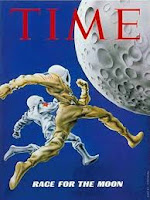Week 9- Space and Art
Week 9
For me, as well as most kids I'm sure, space is fascinating. The endless possibilities and discoveries never cease to amaze. So much so, the first classed I ever enrolled for at UCLA was Astronomy 3. But while space mass everything seem huge, it also reminds you just how small things really are. Like in the power of 10s video, with a simple exponent, you can go from something as small as an atom to as large as a galaxy. This is why there was a need for explorationAs many things went in the mid 1900s, the space exploration was really a 2 man race between the United States and Soviet Union.
 |
| Here, a time magazine cover in the 1960's depicts the US and Soviet's battle to reach space first |
Space, like every other part of science, has had its doubters and setbacks. Whether it be the catholic church challenging Galileos opinions about planets, or other scientists disagreeing with Copwenicuos rotation model, there have always been people who have stood up for what they know is right, even when everyone else tells them they are wrong. To even come up with their ideas however, they needed to be creative.
One prime example of creativity not in regards to science was discussed during the lecture. Jules Verne's 1865 novel about weightlessness in space for example was almost 100 years before people actually got to enter the vast abyss. The Jetsons, star trek, and Star Wars are also popular TV's and movies that drove people's hunger and fascination for space, especially mine.
 |
| Here, the Millennium Falcon in Star Wars is accelerating to light speed |
To me however, the most fascinating part of space has to be the commercial travel.
 |
| One of the many artistic representations of what a Virgin Galactic aircraft may look like in space |
Bibliography
"Dragon Resupply Mission (CRS-11)." SpaceX. SpaceX, 29 Jan. 2016. Web. 04 June 2017.
History.com Staff. "The Space Race." History.com. A&E Television Networks, 2010. Web. 03 June 2017.
Langewiesche, William, and Jonas Fredwall Karlsson. "Everything You Need to Know About Flying Virgin Galactic." The Hive. Vanity Fair, 31 Mar. 2015. Web. 04 June 2017.
MARS PATENT: Welcome. The Mars Patent, 2015. Web. 04 June 2017.
Tate, Karl. "How Intercontinental Ballistic Missiles Work (Infographic)." Space.com. N.p., 2016. Web. 02 June 2017.



I thought it was interesting how you brought up the idea that artists used their creativity to foreshadow ideas and concepts which science would not actually truly explore and discover till centuries later. The example about Jules Verne's 1965 novel on weightlessness was a great example of this. Verne was truly a visionary of his time to be able to comprehend this concept well enough to write about it decades before humans truly experienced weightlessness for the first time. Great insight!
ReplyDelete